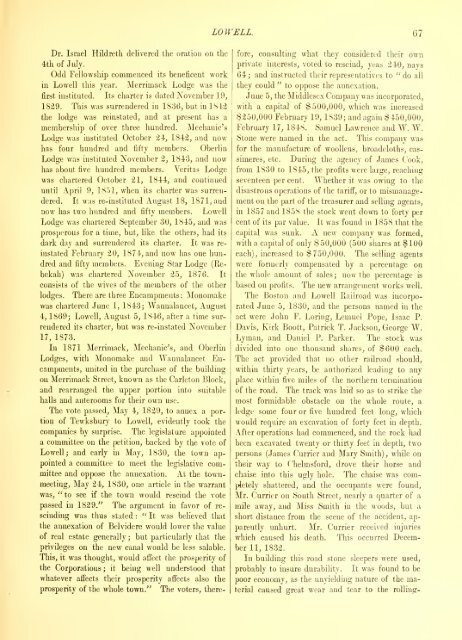History of Middlesex County, Massachusetts - citizen hylbom blog
History of Middlesex County, Massachusetts - citizen hylbom blog
History of Middlesex County, Massachusetts - citizen hylbom blog
You also want an ePaper? Increase the reach of your titles
YUMPU automatically turns print PDFs into web optimized ePapers that Google loves.
Dr. Israel Hildreth delivered the oration on the<br />
4th <strong>of</strong> July.<br />
Odd Fellowship commenced its beneficent work<br />
in Lowell this year. Merrimack Lodge was the<br />
first instituted. Its charter is dated November 19,<br />
1829. This was surrendered in 1836, but in 184.2<br />
the lodge was reinstated, and at present has a<br />
membership <strong>of</strong> over three hundred. Mechanic's<br />
Lodge was instituted October 24, 1842, and now<br />
has four hundred and fifty members. Oberlin<br />
Lodge was instituted November 2, 1843, and now<br />
has about five hundred members. Veritas Lodge<br />
was chartered October 21, 1844, and coutinued<br />
until April 9, 1851, when its charter was surrendered.<br />
It was re-instituted August 18, 1871, and<br />
now has two hundred and fifty members. Lowell<br />
Lodge was chartered September 30, 1845, and was<br />
prosperous for a time, but, like the others, had its<br />
dark day and surrendered its charter. It was re-<br />
instated February 20, 1874, and now has one hun-<br />
dred and fifty members. Evening Star Lodge (Re-<br />
bekah) was chartered November 25, 1876. It<br />
consists <strong>of</strong> the wives <strong>of</strong> the members <strong>of</strong> the other<br />
lodges. There are three Encampments : Monomake<br />
was chartered June 1, 1843; Wannalancet, August<br />
4, 1869; Lowell, August 5, 1846, after a time surrendered<br />
its charter, but was re-instated November<br />
17, 1873.<br />
In 1871 Merrimack, Mechanic's, and Oberliii<br />
Lodges, with Monomake and AVannalancet En-<br />
campments, united in the purchase <strong>of</strong> the building<br />
on Merrimack Street, known as the Carleton Block,<br />
and rearranged the upper portion into suitable<br />
halls and anterooms for their own use.<br />
The vote passed. May 4, 1829, to annex a por-<br />
tion <strong>of</strong> Tewksbury to Lowell, evidently took the<br />
companies by surprise. The legislature appointed<br />
a committee on the petition, backed by the vote <strong>of</strong><br />
Lowell; and early in May, 1830, the town ap-<br />
pointed a committee to meet the legislative committee<br />
and oppose the annexation. At the town-<br />
meeting. May 24, 1830, one article in the warrant<br />
was, "to see if the town would rescind the vote<br />
the annexation <strong>of</strong> Belvidere would lower the value<br />
<strong>of</strong> real estate generally ; but particularly that the<br />
privileges on the new canal would be less salable.<br />
This, it was thought, would affect the prosperity <strong>of</strong><br />
the Corporations ; it being well understood that<br />
whatever affects their prosperity affects also the<br />
prosperity <strong>of</strong> the whole town." The voters, there-<br />
LOWELL. (57<br />
fore, consulting what they considered their own<br />
private interests, voted to rescind, yeas 240, nays<br />
64 ;<br />
and instructed their representatives to " do all<br />
they could " to oppose the annexation.<br />
June 5, the <strong>Middlesex</strong> Company was incorporated,<br />
with a capital <strong>of</strong> §500,000, which was increased<br />
§250,000 February 19, 1839; and again S450,000,<br />
February 17, 1848. Samuel Lawrence and W. W.<br />
Stone were named in the act. This company was<br />
for the manufacture <strong>of</strong> woollens, broadclotlis, cas-<br />
simeres, etc. During the agency <strong>of</strong> James Cook,<br />
from 1830 to 1845, the pr<strong>of</strong>its were large, reaching<br />
seventeen per cent. Whether it was owing to the<br />
disastrous operations <strong>of</strong> the tarifi', or to mismanagement<br />
on the part <strong>of</strong> the treasurer and selling agents,<br />
in 1857 and 1858 the stock went down to forty per<br />
cent <strong>of</strong> its par value. It was found in 1858 that the<br />
capital was sunk. A new company was formed,<br />
with a capital <strong>of</strong> only §50,000 (500 shares at $100<br />
each), increased to S 750,000. The selling agents<br />
were formerly compensated by a percentage on<br />
the whole amount <strong>of</strong> sales; now the percentage is<br />
based on pr<strong>of</strong>its. The new arrangement works well.<br />
The Boston and Lowell Railroad was incorpo-<br />
rated June 5, 1830, and the persons named in the<br />
act were John F. Loring, Lemuel Pope, Isaac P.<br />
Davis, Kirk Boott, Patrick T. Jackson, George W.<br />
Lyman, and Daniel P. Parker. The stock was<br />
divided into one thousand shares, <strong>of</strong> S600 each.<br />
The act provided that no other railroad should,<br />
within thirty years, be authorized leading to any<br />
place within five miles <strong>of</strong> the northern termination<br />
<strong>of</strong> the road. The track was laid so as to strike the<br />
most formidable obstacle on the whole route, a<br />
ledge some four or five hundred feet long, which<br />
would require an excavation <strong>of</strong> forty feet in depth.<br />
.\fter operations had commenced, and the rock had<br />
been excavated twenty or thirty feet in depth, two<br />
persons (James Currier and Mary Smith), while on<br />
their way to Chelmsford, drove their horse and<br />
chaise into this ugly hole. The chaise was com-<br />
pletely shattered, and the occupants were found,<br />
Mr. Currier on South Street, nearly a quarter <strong>of</strong> a<br />
passed in 1829." The argument in favor <strong>of</strong> re- mile away, and Miss Smith in the woods, but a<br />
scindmg was thus stated " : It was believed that short distance from the scene <strong>of</strong> the accident, ap-<br />
parently unhurt. Mr. Currier received injuries<br />
which caused his death. This occurred Decem-<br />
ber 11, 1832.<br />
In building this road stone sleepers were used,<br />
probably to insure durability. It was found to be<br />
poor economy, as the unyielduig nature <strong>of</strong> the ma-<br />
terial caused great wear and tear to the rolling-

















